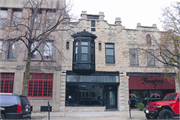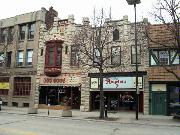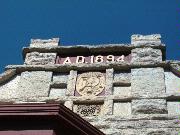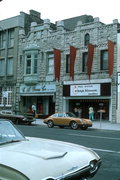Property Record
115 N ADAMS ST
Architecture and History Inventory
| Historic Name: | Rockstroh Bakery |
|---|---|
| Other Name: | The Heel |
| Contributing: | Yes |
| Reference Number: | 1922 |
| Location (Address): | 115 N ADAMS ST |
|---|---|
| County: | Brown |
| City: | Green Bay |
| Township/Village: | |
| Unincorporated Community: | |
| Town: | |
| Range: | |
| Direction: | |
| Section: | |
| Quarter Section: | |
| Quarter/Quarter Section: |
| Year Built: | 1894 |
|---|---|
| Additions: | |
| Survey Date: | 19862017 |
| Historic Use: | bakery |
| Architectural Style: | Commercial Vernacular |
| Structural System: | |
| Wall Material: | Stone - Unspecified |
| Architect: | |
| Other Buildings On Site: | |
| Demolished?: | No |
| Demolished Date: |
| National/State Register Listing Name: | Green Bay Downtown Historic District |
|---|---|
| National Register Listing Date: | 5/13/2019 |
| State Register Listing Date: | 2/16/2018 |
| National Register Multiple Property Name: |
| Additional Information: | A 'site file' exists for this property. It contains additional information such as correspondence, newspaper clippings, or historical information. It is a public record and may be viewed in person at the Wisconsin Historical Society, Division of Historic Preservation-Public History. Photo code #2: 75BR-13/28. Fine Richardsonian Romanesque inspired design topped by a complex cut stone parapet which features a pressed tin plaque. The design on the plaque incorporates a sickle and a sheaf of wheat, symbolizing the baker's trade, with a date panel above it which reads "A.D. 1894". The entire facade is covered in rock-faced cut stone typical of the Richardsonian Romanesque style, and which is used here to give a more picturesque appearance to a form more typically done in brick and which can be found in several other Green Bay examples. Cut stone pilasters flank the altered display windows which have a cast iron beam above as a lintel, and which is ornamented with cast-iron rosettes and strapwork. Above is an asymmetrically placed polygonal oriel window which has a rounded base and panels between the windows decorated with swags. The oriel also has a stepped hip roof. There are seven skylights, with gun turret windows on the sides of the building. The interior of the 1st floor retains its original wooden ceiling composed of varnished tongue and groove wood strips and divided into panels by raised wooden boards. Several of the intersecting of these boards have wooden roundels for ceiling fans. The apartment and the facade were restored to its original form by owner Bob Sanderson in the 1980s. The building is clearly related in style and period to the less elaborate examples next door at 117 N. Adams Street. The Rockstrohs ran a bakery and confectionery business on the first floor of the building and lived on the second floor. The last remaining Rockstroh family member lived in the upstairs apartment until c. 1978, when they sold the building to the C.A. Gross Company, who ran a women's clothing store here. In 1982, the building was sold to Bob Sanderson, proprietor of The Heel. 2017-NRHP District Nomination The Rockstroh family had this building constructed in 1894—the first floor housed their bakery and confectionary business while the second floor served as their residence. J. C. Rockstroh hauled the stone for his foundation. The building was owned continuously by members of the Rockstroh family until the late 1970s. Stylistically, the building was inspired by Richardsonian Romanesque architecture, with a façade that is covered entirely in rock-faced cut stone typical of the style. The first floor features altered storefront windows and an entry at the right, all of which is situated between cut stone pilasters at the extreme width of the façade. Signage is situated above the windows and entry, with an iron beam above that serves as the lintel. Cast rosettes and strapping details embellish the lintel beam. The second story has a polygonal oriel window at left with a stepped, hip roof and a rounded base that extends to the bottom of the iron beam lintel below. The base of the oriel has laurel swag embellishments just below the window sills. A narrow, vertical, loophole-like window is on the main façade to either side of the oriel. The right side of the second story features a two-pane window with transom window above. The top of the façade consists of a complex cut stone parapet. A pressed tin plaque with a sickle and sheaf of wheat honors the baker’s trade, and a panel with “A.D. 1894” proclaims the year of construction of the building. |
|---|---|
| Bibliographic References: | (A) Historic name: Deborah L. Martin, History of Brown County: Past and Present (Chicago, 1913), Vol. II, p.395 (B) Daily State Gazette. Green Bay, Wisconsin. 12 Mar 1894, page 3. (C) State Gazette. Green Bay, Wisconsin. 17 Jan 1894, page 1. |
| Wisconsin Architecture and History Inventory, State Historic Preservation Office, Wisconsin Historical Society, Madison, Wisconsin |





